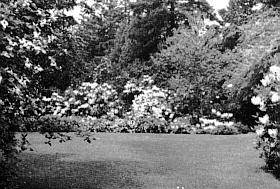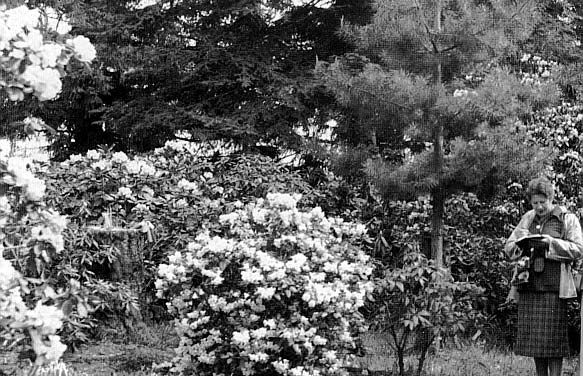Rhododendron Notes
Watering and mulching will be most important in rhododendron culture during the hot summer months. Soak the plants every ten days or two weeks, be certain that roots are kept damp. A rhododendron with roots in good condition will seldom have burned foliage. To protect surface roots from heat and to conserve moisture mulch plants heavily. In the northwest, sawdust is probably our best mulch.
Ten years ago this month, the July 1949 Bulletin, published an interesting story by Dr. J. Harold Clarke, about the International Rhododendron Conference in England, which he had attended. The Dr. Rock seed had arrived and was an important part of every rhododendron discussion. Del James, Eugene, bloomed R. taggianum for the first time.
It's mid June and there is still good rhododendron color in many northwest gardens. But these late bloomers need protection from the hot afternoon sun which can spoil flowers before they are fully open. In shady gardens 'Mars', 'Margaret Dunn', 'Glow', 'Jade', 'Azor', and others are often seen. 'Lodauric', a plant we have always admired for its fine growth habit and fragrant flowers, is just coming into good bloom. Our plant is six feet tall and twelve feet across, with a bud on every terminal. Buds on R. discolor , R. auriculatum and 'Polar Bear' are still quite tight.
Plants we thought outstanding this season: two very large and beautifully grown R. calophytum in the garden of Mrs. A. C. U. Berry. In the same garden a tall growing fine lemon-yellow seedling with unusually heavy substance in the flowers, probably close to R. wardii . R. wardii in the garden of Rudolph Henny, a big seven or eight foot plant, a fine form covered with flowers, it is always spectacular. R. 'Captain Jack,' his fine red hybrid, was the best ever.
Cecil Smith, Aurora, Oregon, bloomed a big R. rex wonderfully well but his big show was R. yakushimanum , the award form with its pure white flowers. His beds of R. yakushimanum hybrids ranging in color from white through shades of pink and orange, were fine. One of these hybrids received a P.A. at the Portland show.
One of the most effective groupings of big growing rhododendrons we have seen is at the home of Henry Wessinger in Portland. At the end of a wide sweep of beautiful lawn, surrounded on three sides by firs, native dogwood and other large shrubs and trees, is a bed of eight and ten foot plants of 'Loderi', 'Faggetter's Favorite' and 'Mother of Pearl', bordered with white azaleas. It is particularly spectacular when you turn a corner and suddenly see it before you. (Fig. 44)

|
|
Fig. 44. Large Specimen rhododendrons
in the Henry Wessinger Garden. Bovee photo |
"Modern Shrubs," another hook by E. H. M. Cox & P. A. Cox, is as valuable an addition to horticulture as was "Modern Rhododendrons." It is most interestingly written and gives a long list with descriptions of many of the best shrubs and vines for the garden, and it tells why these plants are desirable. There are chapters on cultivation and propagation.
In Seattle for the Rhododendron Show last month, we were able to visit four fine and most interesting gardens. Time was short so just a quick impression of each ... the Pendleton Miller garden where we have never seen Gaultheria grown so well or Cornus canadensis looking so happy under cultivation. Masses of rhododendrons, both species and hybrid, and Knaphill azaleas. The Henry Isaacson garden is on a steep hillside, on many levels. Looking down on the garden from the patio a wisteria vine in full flower covering a widely spreading tree first catches the eye. Hundreds of rhododendrons and other fine shrubs are massed. In this garden we saw a very large plant of R. campylocarpum in full bloom, one of the best plants of this species we have seen. The fine home of Mrs. Kerry Trimble, overlooks a very large, very green and well kept lawn; an outstanding example of how wonderfully a fine lawn can display good shrubs and trees. Here are some of the largest rhododendrons we have seen grown among the firs, dogwoods and other trees and shrubs. The garden of Donald Graham has long been considered one of the "show" rhododendron gardens of the northwest. It is beautifully landscaped and the big rhododendrons were in full bloom the day of our visit. It would be difficult to select outstanding plants in this garden, there are so many fine ones. But R. 'Snow Queen', a favorite of ours, particularly attracted us, the biggest plant of it we have seen and a mass of bloom. We had time just for a brief look at the University of Washington Arboretum, before driving home. A trip through the lath house under the guidance of Brian C. Mulligan, curator, was interesting for it contains many good plants. (Fig. 45)

|
|
Fig. 45. Mrs. B. O. Mulligan, wife of the director of the University
of Washington taking notes on a visit to an Oregon rhododendron garden. Bovee photo |
In our garden two big plants of 'Moonstone' have been outstanding this season, never before have they bloomed so heavily. The Knaphill azaleas become more beautiful each year as they become larger and better established. Flowers definitely increase in size on older plants. Three particularly good Knaphills showed this year, a big buff heavily over laid with bright red-orange was spectacular. But the "tops" were a bright old gold with 4½" to 5" flowers, 12 to 14 to the truss, perhaps the biggest flowered Knaphill we have seen. A fine buff with flowers almost as large was equally good. A white flowered R. wardii seedling bloomed heavily and attracted much attention.
A most enjoyable part of this rhododendron season was the visit of David Leach of Brookville, Pa., to the northwest. We liked his interesting talk on eastern native azaleas. His enthusiasm for our plants made us appreciate our gardens and climate even more. Mr. Leach took home with him an exceedingly well pictured story of northwest rhododendrons, we doubt if any visitor has ever before "shot" so many color pictures so fast.
- Bob Bovee
Breeders are again urged to send in names for new clones, for registration, before they are used in print. Some names suggested by various breeders this past spring were found to have been used before. By checking with the Registrar duplication of names, always confusing and embarrassing, may be avoided, at least in so far as the information is available in the International Register.
Plans are progressing for the International Rhododendron Conference to be held in this country in May, 1961. Important names in the Rhododendron world are being sought out as speakers. Included in the tentative plans are technical and informative papers, a show with special features, tours to points of Rhododendron interest and other appropriate activities.
The writer recently made a trip to Dallas, Texas, admittedly not ideal rhododendron territory. However, one very fine home was pointed out where a large bank of azaleas was said to be a "traffic stopper" to the extent of requiring three officers to keep week end traffic moving during the blooming season. Discreet inquiries brought out the information there were a "few" Rhododendrons in Dallas, and that Azaleas are increasing in popularity. One large landscape firm stated they were using mostly 'Hinodegiri', 'Ledifolia Alba', 'Coral Bells' and 'Madame Pericat', with emphasis on the first two.
With literally thousands of rhododendron species and varieties, including the Azaleas, to choose from there are undoubtedly some which will be more resistant than others to hot, dry climate. More testing is needed in areas where the climate is relatively unfavorable, in order to uncover the "tough ones."
- J. Harold Clarke